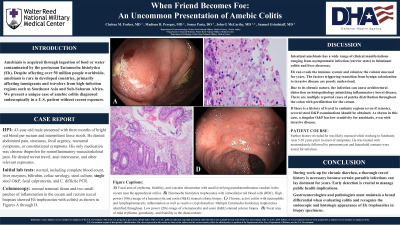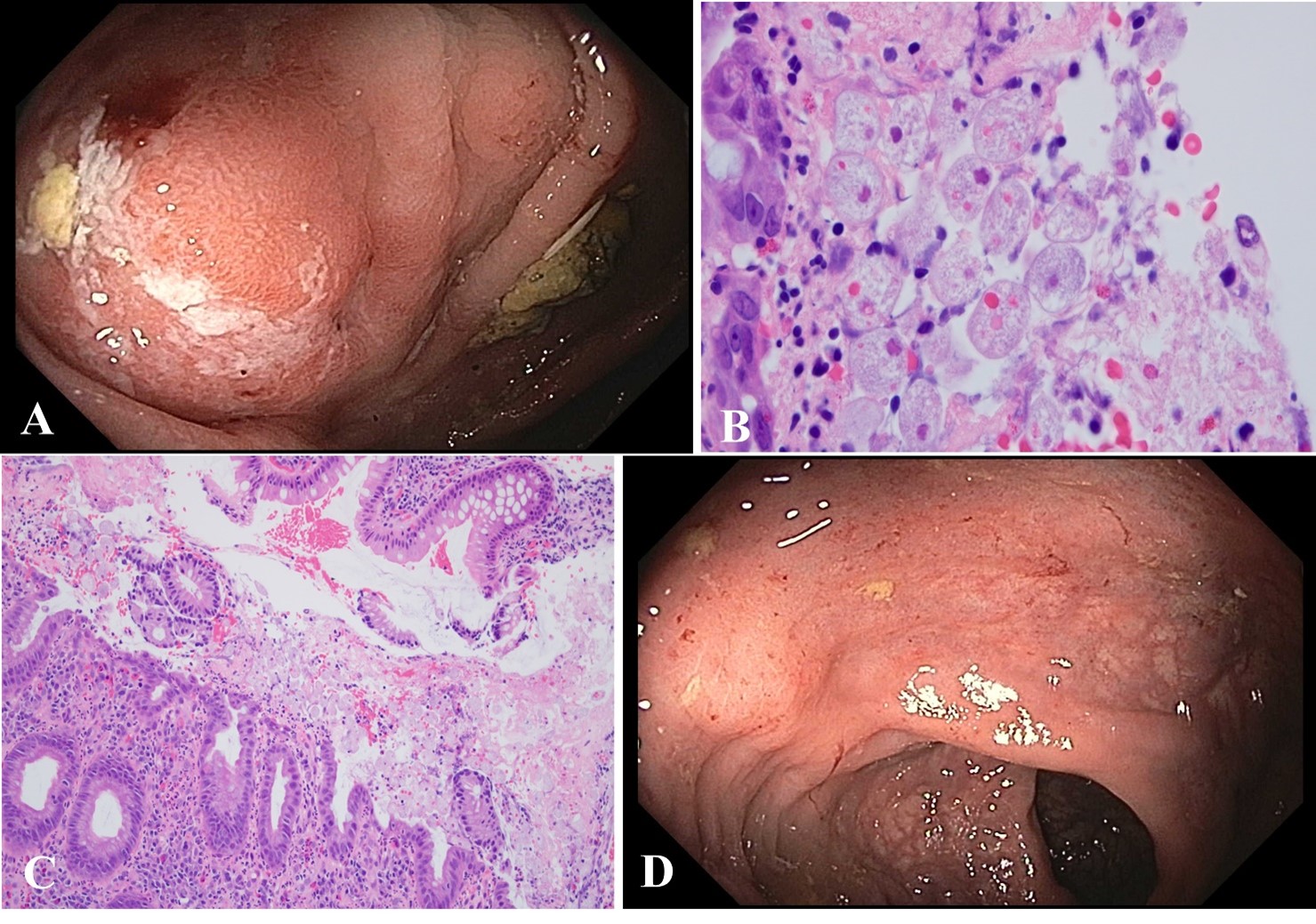Monday Poster Session
Category: Colon
P1971 - When Friend Becomes Foe: An Uncommon Presentation of Amebic Colitis
Monday, October 28, 2024
10:30 AM - 4:00 PM ET
Location: Exhibit Hall E

Has Audio
- CF
Chelsea Forbes, MD
Walter Reed National Military Medical Center
Bethesda, MD
Presenting Author(s)
Chelsea Forbes, MD1, Madison B. Peregoy, MD2, Sonya Pasia, DO1, John G.. McCarthy, MD1, Samuel Grindstaff, MD1
1Walter Reed National Military Medical Center, Bethesda, MD; 2National Capital Consortium, Bethesda, MD
Introduction: Amebiasis is caused by ingesting food or water contaminated with Entamoeba histolytica (Eh). Clinical manifestations range from asymptomatic colonization to fulminant colitis with liver abscesses. Invasive Eh affects over 50 million people globally each year but remains rare in developed countries, except among long-term travelers and immigrants from high-infection regions like Southeast Asia and parts of Africa. We report an unusual case of amebic colitis diagnosed in an American patient without recent exposure.
Case Description/Methods: A 43-year-old male presented with 3 months of hematochezia and intermittent loose stools. He denied abdominal pain, tenesmus, fecal urgency, nocturnal symptoms, or constitutional symptoms. He was not on prescription medications and had not traveled overseas in years. Initial lab tests were unrevealing, including complete blood count, liver enzymes, bilirubin, celiac serology, stool culture, one stool O&P, fecal calprotectin, and C. difficile PCR. On colonoscopy, multiple patches of inflammation were found in the cecum and rectum (Figures A and D). Histopathologic review of the cecal biopsy specimen detected Eh trophozoites consistent with amebic colitis (Figures B and C). At follow-up, the patient was treated with metronidazole followed by paromomycin, and he confirmed his last overseas travel occurred more than 5 years ago.
Discussion: Eh can evade the immune system for years, and factors triggering the transition from benign colonization to invasive disease are still poorly understood. Our patient was likely exposed several years before his diagnosis, underscoring the importance of soliciting a thorough social and travel history for patients with these symptoms. Additionally, the negative stool examination for O&P highlights the low sensitivity of a single examination even in invasive disease. Intestinal amebiasis often has a patchy colonic distribution, with a predilection for the cecum. Due the chronic nature of infection, amebiasis can manifest with histological features of chronicity, like crypt architectural distortion, mimicking inflammatory bowel disease. This has serious clinical implications, because immunosuppressive treatment can trigger fulminant amebic colitis. When evaluating cases of chronic colitis, gastroenterologists must maintain a broad differential and remain familiar with the various endoscopic and histologic appearances of intestinal amebiasis because early detection is crucial to limit community spread and disease complications.

Disclosures:
Chelsea Forbes, MD1, Madison B. Peregoy, MD2, Sonya Pasia, DO1, John G.. McCarthy, MD1, Samuel Grindstaff, MD1. P1971 - When Friend Becomes Foe: An Uncommon Presentation of Amebic Colitis, ACG 2024 Annual Scientific Meeting Abstracts. Philadelphia, PA: American College of Gastroenterology.
1Walter Reed National Military Medical Center, Bethesda, MD; 2National Capital Consortium, Bethesda, MD
Introduction: Amebiasis is caused by ingesting food or water contaminated with Entamoeba histolytica (Eh). Clinical manifestations range from asymptomatic colonization to fulminant colitis with liver abscesses. Invasive Eh affects over 50 million people globally each year but remains rare in developed countries, except among long-term travelers and immigrants from high-infection regions like Southeast Asia and parts of Africa. We report an unusual case of amebic colitis diagnosed in an American patient without recent exposure.
Case Description/Methods: A 43-year-old male presented with 3 months of hematochezia and intermittent loose stools. He denied abdominal pain, tenesmus, fecal urgency, nocturnal symptoms, or constitutional symptoms. He was not on prescription medications and had not traveled overseas in years. Initial lab tests were unrevealing, including complete blood count, liver enzymes, bilirubin, celiac serology, stool culture, one stool O&P, fecal calprotectin, and C. difficile PCR. On colonoscopy, multiple patches of inflammation were found in the cecum and rectum (Figures A and D). Histopathologic review of the cecal biopsy specimen detected Eh trophozoites consistent with amebic colitis (Figures B and C). At follow-up, the patient was treated with metronidazole followed by paromomycin, and he confirmed his last overseas travel occurred more than 5 years ago.
Discussion: Eh can evade the immune system for years, and factors triggering the transition from benign colonization to invasive disease are still poorly understood. Our patient was likely exposed several years before his diagnosis, underscoring the importance of soliciting a thorough social and travel history for patients with these symptoms. Additionally, the negative stool examination for O&P highlights the low sensitivity of a single examination even in invasive disease. Intestinal amebiasis often has a patchy colonic distribution, with a predilection for the cecum. Due the chronic nature of infection, amebiasis can manifest with histological features of chronicity, like crypt architectural distortion, mimicking inflammatory bowel disease. This has serious clinical implications, because immunosuppressive treatment can trigger fulminant amebic colitis. When evaluating cases of chronic colitis, gastroenterologists must maintain a broad differential and remain familiar with the various endoscopic and histologic appearances of intestinal amebiasis because early detection is crucial to limit community spread and disease complications.

Figure: A) Focal area of erythema, friability, and vascular obscuration with small overlying pseudomembranous exudate in the cecum near the appendiceal orifice. B) Entamoeba histolytica trophozoites with intracellular red blood cells (RBC). High power (100x) image of a hematoxylin and eosin (H&E) stained colonic biopsy. C) Chronic, active colitis with neutrophilic and lymphoplasmacytic inflammation as well as reactive crypt distortion. Multiple Entamoeba histolytica trophozoites identified throughout. Low power (20x) image of a hematoxylin and eosin (H&E) stained colonic biopsy. D) Focal area of mild erythema, granularity, and friability in the distal rectum.
Disclosures:
Chelsea Forbes indicated no relevant financial relationships.
Madison Peregoy indicated no relevant financial relationships.
Sonya Pasia indicated no relevant financial relationships.
John McCarthy indicated no relevant financial relationships.
Samuel Grindstaff indicated no relevant financial relationships.
Chelsea Forbes, MD1, Madison B. Peregoy, MD2, Sonya Pasia, DO1, John G.. McCarthy, MD1, Samuel Grindstaff, MD1. P1971 - When Friend Becomes Foe: An Uncommon Presentation of Amebic Colitis, ACG 2024 Annual Scientific Meeting Abstracts. Philadelphia, PA: American College of Gastroenterology.

